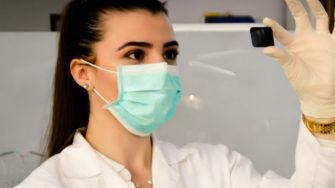
We apply our mechanical engineering expertise and facilities to enhance the fundamental understanding of the mechanics of health problems. We use computational and experimental techniques to determine the underlying mechanics for a range of health-related problems.
Experimental visualisation and numerical modelling of aerosol/droplet dispersion from respiratory exhalations
This area of research involves the development of flow diagnostics to examine the flow dynamics of droplets expelled during various respiratory events such as speaking / singing / coughing / sneezing. We also test the effectiveness of Personal Protective Equipment (PPE) such as face coverings / shields. The measurements have capability to capture fully resolved three-dimensional droplet/particle laden flows to directly measure particle velocity and size using non-invasive image-based techniques. The project also includes testing of respiratory flows in specific conditions and environments and confined spaces.
We also collaborate with our colleagues in other research centres such as Kirby Institute.
Large data
Using large data science, artificial intelligence and deep learning, we use medical image data to tackle some of the most pressing healthcare questions to date. These include representations of a large population to drive personalised medicine of the future by providing a reliable and early risk assessment, improving patient care and enabling patient-specific treatment. We work with clinicians, industry, philanthropists and not-for-profit funding agencies.
Some of our exciting projects include:
Novel biomarker detection for outcome prediction in patients with suspected coronary artery disease
Automatic haemodynamic risk assessment from CT coronary angiography images.
For more information, visit Coronary Atlas
Bioheat transfer and advanced bio-nanomaterials for hyperthermia and diagnostics
Thermal transfer plays an important role in many biological processes. With a special emphasis on bioheat transfer, our aim is to destroy cancer cells or bacteria. We use gold nanoparticles (GNPs) heated by a laser as a tool for the localised hyperthermia in the vicinity of targeted diseased cells.
We investigate the effects of local heating from gold nanoparticles irradiated by lasers on biological cells and tissues. We use computational modelling as well as artificial lipid membrane systems developed by our partners at Surgical Diagnostics Pty Ltd and UTS. Irradiated modified GNPs, such as streptavidin-conjugated GNPs, are embedded in the tethered bilayer lipid membranes (tBLMs) assembled on gold electrodes that contain target molecules, for example, biotin.
The heat transfer between irradiated gold nanoparticles (GNPs) and bilayer lipid membranes is studied by the electrochemically induced conductional changes. We also study effects of aggregation of nanoparticles and develop advanced nanomaterials with an optimum enhancement of absorption or scattering of light for thermal therapy and diagnostics.
Our partners
- A/Prof. Michael Jackson (Faculty of Medicine, UNSW, Radiation Oncology, Prince of Wales Hospital)
- Prof. Stella Valenzuela (UTS)
- A/Prof. Bruce Cornell (Surgical Diagnostics Pty Ltd)
- Prof. Dombrovsky (Joint Institute for High Temperatures, Russia)
Development a compact, portable and cost-effective digital polymerase chain reaction (dPCR) platform suitable for point-of-care diagnostics
Polymerase chain reaction (PCR) technology has been used to detect various diseases and is essential part of testing in the recent COVID-19 pandemic. Digital PCR has higher accuracy and sensitivity than standard PCR which translates to fewer diagnostic errors and opens the possibility to detect the presence of positive cases at an earlier stage.
The digital PCR process achieves unparalleled sensitivity by partitioning DNA templates into small volume (e.g. micro/nanolitre-size) reaction chambers to enable detection of trace amounts within a sample. The partitioned DNA templates are replicated during the amplification step, which involves thermal cycling in the presence of reagents to generate molecular products that can be detected through fluorescence imaging.
We study the mechanisms of rapid heating and cooling of microscopic liquid portions at the nanoliter scale and develop a rapid thermal cycler for a digital dPCR platform to improve the overall test performance and to enable manufacturing of point-of-care diagnostics devices.
Our partner
- Dr. Jonathan Shemesh, Sydnov







